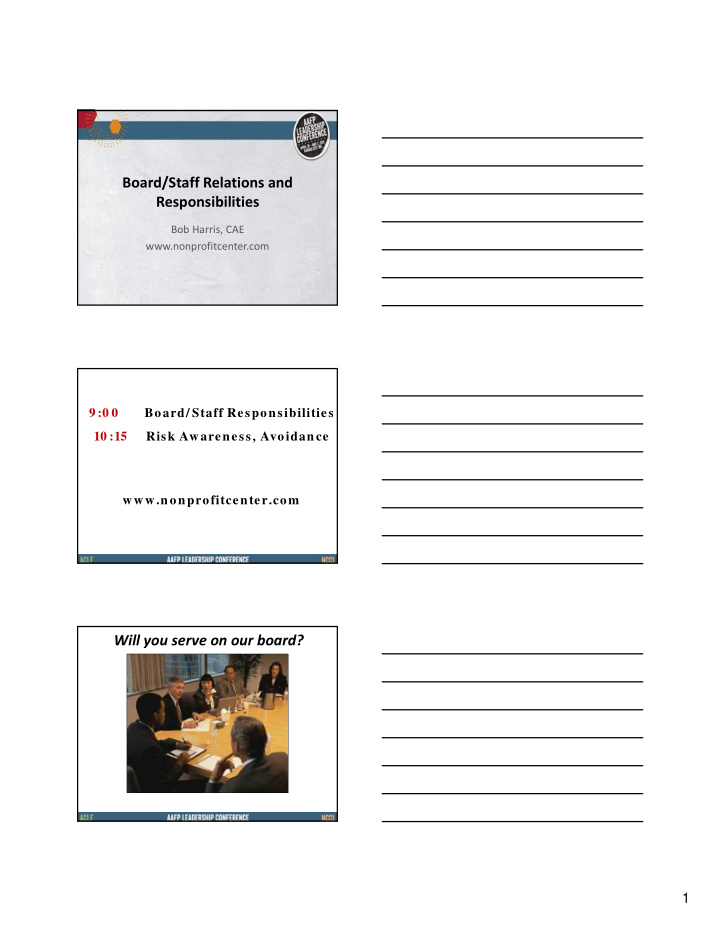



Board/Staff Relations and Responsibilities Bob Harris, CAE www.nonprofitcenter.com 9:0 0 Board/ Staff Responsibilities 10 :15 Risk Awareness, Avoidance www.nonprofitcenter.com Will you serve on our board? 1
Protecting the Board 1. Volunteer Immunity 2. D & O 3. Incorporation 4. Indemnification Governed by: State Corporate Law Internal Revenue Service – 501c6 – trade association – 501c3 – foundation Canada Province, National, Charity Act, etc. 2
Myths 1. Our records are public. 2. We can’t make a profit or have significant savings. 3. Cannot take a political position as a nonprofit. 4. Missing meetings is OK. 5. Silence is OK Governing Documents Mission (Purpose for existence) Articles of Incorporation (Relationship to state gov’t.) Bylaws (Relationship to members) Policies (interpretation of the governing documents) Strategic Plan (roadmap for the organization) Annual Budget It Takes a Partnership Governance Executive Director Group of persons The person who has authorized to make ultimate responsibility governance decisions for implementing the on behalf of the decisions of the organization and its governing body. members. 3
The Partnership The board is visionary. Leading the profession and improving health. Board of Directors Work Groups 50,000' and Committees 25,000 ‐ Staff 40,000' 10,000' 4
Fiduciary Principles IRS Policies Director Commitment 1. Read, uphold governing documents. 2. Advance the mission; serve the members. 3. Respect confidentiality of discussions, documents. 4. Disclose conflicts of interest. 5. Avoid antitrust violations. 5
1. Advance the Mission Purpose of existence Frames all work/programs. Update periodically Mission, Vision, Values 6
7
2. Partner with the Exec Dir. Board – Staff team Avoid interfering with Exec Dir. relationship. ‐ lines of authority . Org Chart ? 3. Evaluate Performance • Budget Performance Exec Dir. ‐ Administrator • Performance Board Self Evaluation* • • Confidential • Self evaluation • Internal discussion • 6 months into term, or end of term 8
9
4. Strategic Direction Board is the visionary body. Written in form of a “Strategic Plan.” Reviewed annually. Fully updated 3 to 5 years. 10
5. Sufficient Resources Budget income streams. Savings ‐ reserve. Staffing. Volunteers and committees. Facilities – office. Technology Revenue Ratio Member Dues Non ‐ Dues • Advertising • Sponsorship • Endorsements/Royalties • Trade Show/Expo • Interest • Product Sales • Education, Meetings • Gifts, Grants 6. Protect the Resources Insurance coverages Audit & audit committee. Board accountability, oversight. 11
Diversions 7. Programs, Services, Value Serving Members’ Needs Portfolio of Benefits “Golden Handcuff “ Drop/Revamp Old Programs 8. Promote the Organization Know the mission. Focus on goals. Talking points and positions. Follow lines of authority. 12
“I can’t speak for the board but I can give you my personal opinion .” Policy Sample No one shall purport to be an official spokesperson for the organization except the elected president of the board or a person or persons designated. 9. Legal ‐ Ethical Integrity Insurance Conflicts of Interest disclosed Filings Antitrust 13
10. Leadership Sustainability Board Orientation Leadership Programs Young, Diverse Leaders Succession Plan? Board, Staff? Common Board Challenges 1. Board Size 2. Governance or Micromanagement? 3. Lacking Financial Acumen 4. Conflicts of Interest 5. Meetings – MIA/AWOL 6. No vision, short term thinking 14
1. Chair & Vice Chair 2. Alignment with Goals 3. Purpose Statement 4. Current Year Charges 5. Metrics, Timelines 6. History/Notebook 7. Board – Staff Liaison 8. Agendas 9. Minutes 10.Committee Notebook or Portal Protecting the Board 1. Volunteer Immunity 2. D & O 3. Incorporation 4. Indemnification 15
Governed by: State Corporate Law Internal Revenue Service – 501c6 – trade association – 501c3 – foundation Canada Province, National, Charity Act, etc. Risk Management Concept 1. Identify Risks 2. Assess/Evaluate 3. Control/Manage 4. Monitor/Review 16
17
Recommend
More recommend